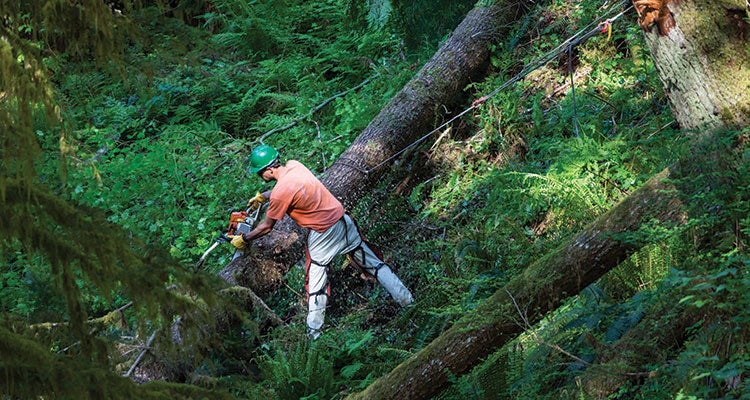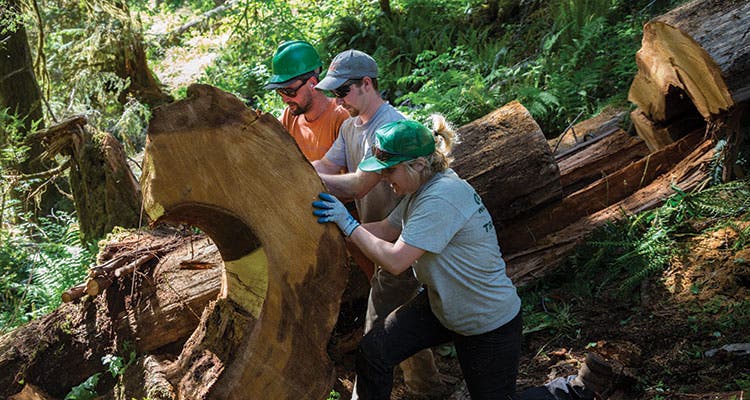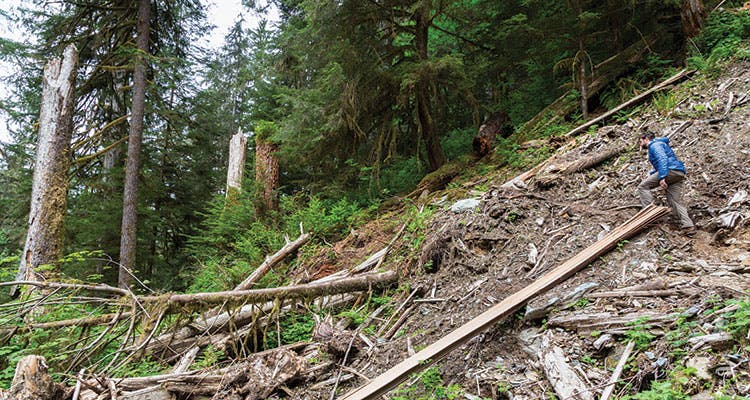How Trail Crews Fight the Forest in Olympic National Park

'Workers labor to tame the forest. Photo by: Tegra Stone Nuess'
Don’t believe the guidebooks or gorgeous photos: Olympic National Park doesn’t want you. Nine months a year, the wilderness acts like a malevolent force bent on keeping hikers from ever setting foot there. Its near-8,000-foot peaks haul in storms off the North Pacific, howlers weaned on the Arctic and teethed on Alaskan sea ice. When the peninsula’s spiky geology embraces clouds, it wrings out the most precipitation in the Lower 48: 30 feet of snow up high, 150 inches of rain down below. Biology can’t withstand the weather. Old-growth Sitka spruces 8 feet in diameter bow and then break under winter gales, and rivers, churning with mountain-shearing force, plot new watercourses through temperate rainforest, siphoning tons of rock and vomiting them into meadows. A single season’s worth of meteorological warfare can vaporize bridges and bury miles of switchbacks under quick-churned biomass.
Right now, I’m looking at a tiny example of what that power can do to a trail. Well, relatively tiny. There’s a 60-foot tree with a rootball the size of a FedEx truck blocking the East Fork Quinault River Trail a quarter-mile from my camp. The trail is impassable; it’s choked with mud, dangling ferns, and rocks mashed into the rootball. The whole mess is tethered to the mountain by tenacious roots.
Few hikers will make it up the East Fork Quinault this year if this rootball remains in place. But it won’t. Every March, Olympic National Park trail builders take on the monumental task of rebuilding perhaps more miles of trail than any other crew in the country. Chainsaw bushwhackers swarm the hills like ants, crack helicopter pilots surgically remove broken bridges, and trail planners plot workarounds where a river has rerouted a valley. But first, four of its finest are going to move this damn tree.
“In theory, the beast should move,” Olympic trail crew leader Lynn Gunther shouts, leaning his burly frame to peer at the teal rapids 200 feet below. “We’ll rig the tree so as he saws it off it will roll downhill by itself, hopefully into the river. If it doesn’t … Well, it’s going to be interesting.”
Despite being visible from Seattle, the interior of Olympic resisted gold rushes and ages of exploration until 1889, when a Seattle newspaper called for “hardy citizens … to acquire fame by unveiling the mystery which wraps the land encircled by the snow-capped Olympic range.” Six men launched the Press Expedition, along with two mules, four dogs, and a flat-bottom boat meant to ferry 1,500 pounds of supplies. The boat sank. Both mules died. An elk killed a dog. Shattered and starving on flour soup, the party emerged from the North Fork Quinault six months later.
You can retrace their route now in about four or five days, thanks to a red-carpet trail system. No roads penetrate the core of the park. The only way to see it is on foot, and since the park’s inception as a monument in 1909, the NPS has employed hard-as-nails trail crews to thread paths through a remarkably fast-growing and turbulent ecosystem. Most of them rely on little more than hand tools, mules, and the occasional chainsaw. Though helicopter assists happen, they were more common in freewheeling yesteryear before the park curtailed flights to keep from disturbing the wildlife.
“In the old days, you could fly in on a helicopter, show up at the top of a pass, and bring in a basket of oysters and a bucket of beer,” Gunther recalls. “I miss it a bit.”
Like Gunther, Larry Lack comes from this leathered tradition. The Olympic National Park trail supervisor has spent 37 of his 55 years repairing these paths, ensuring the public has access to the sky-high trees, alpine meadows, and glaciated peaks in the roadless 1,442-square-mile interior. His open-air office in Port Angeles is halfway to a mechanic’s garage and bears the relics of a trail grunt who has risen to general: rusting, 8-foot saw blades hang on the walls next to beat-up trail signs.
“I ran mule pack strings for 14 years and then somehow worked my way into a desk job. I miss being in the field, but I’m not sure my body could do it anymore,” he says with a rasp. “But I grew up in Port Angeles���the park is my backyard and I take pride in showing it off to people, providing access, and making it a little bit easier to get back there and enjoy it.”
Bearded and blue-eyed, he’s seen the Olympics at their angriest. A glacial river once shifted and buried a 12-foot-tall backcountry shelter, leaving only a few inches at the peak of the roof poking out of the gravel bar. Once, a bank blew out and gully-washed a steel bridge; one 70-foot steel I-beam just up and disappeared. Even building a sidehill trail in the rainforest means digging through 5 or 6 feet of forest duff and rotten wood—and that’s if you can cut through salmonberry bushes that grow 12 feet a year.
“Come spring, we have the most devastated trails in the park system,” says veteran Hoh Rain Forest-area interpretive ranger Jon Preston. “It looks like bombs went off.”
These are the hardest trails to clear in America, and this was not a good year. Nearly 13 feet of rain fell between October 1 and mid-March alone. The Quinault River swelled so much, the historic Enchanted Valley Chalet was close to collapsing into it; the park flew in a construction crew to lift the 86-year-old shelter with hydraulic jacks and slide it on steel beams 100 feet away from the river. Starting in late March, Lack broke into this year’s $1.3 million budget to fix as much trail as possible before 4 million people swarm our seventh busiest park this summer. There are 611 miles of trail in Olympic and Lack estimates his assemblage of 70 volunteer, seasonal, and fulltime workers can clean up to 500 in a season.
“It’s a challenge. It seems like you spend all summer getting the trail in shape and about the time you’re done, Mother Nature comes in and rearranges everything again,” Lack says.
That’s the story behind every easy, taken-for-granted mile of trail in the park. Crews spend their summers scratching detailed plans in the dirt, tugging on white-shirt higher-ups for pennies, and blowing hours and rivers of human sweat to earn back a few miles of trail for an oblivious public that thinks they pick up trash for a living. As they finish, rain drops let them know an engorged ecosystem is about ready to shake the Etch-A-Sketch on their life’s work. Again.
But without them, it’d be a lot harder to see much of the parks.

The East Fork Quinault River is one of the hardest-hit spots in the park. It leads from river-bottom rainforest to airy, 4,464-foot Anderson Pass over 18.5 miles. In between lies a graveyard of downed trees, scores of blown ravines, and a quarter-mile section of river where trail used to be. Progress so far: 2.5 miles, right up to that big spruce and its tenacious rootball.
The tree slid from the uphill side of the switchbacking trail and toppled so that the trunk points down the 60-degree slope toward a cliff that drops into the Quinault. No backhoes or cranes: The crew will use a complex rigging of steel cables, ropes, and blocks all attached to an intimidating-looking hand winch called a Griphoist. Nothing but human muscle and mechanical tension to move a multiton object, all so a dumb-dumb hiker like me doesn’t have to belly-flop over an old-growth tree trunk like a seal.
From March to October, the five-person crew works eight days on, six days off, spending 10 hours a day marching up the trail with shovels, chainsaws, and pulaskis to carve the corridor back to its standard 8-foot-by-10-foot clearance, mile by mile, foot by foot, inch by precious inch.
Lynn, the crew’s leader, is a blue-collar wise man: When nature refuses to operate on schedule, he says things like “time isn’t real … money isn’t either” and lights up a hand-rolled cigarette. Besides sculpting trails to look like “God did it,” he delights in guiding us to quartz crystal hordes accreting under upended old-growth trees, or his favorite salmon-spawning eddy in a river bend.
“I’ve always spent time in the woods—it’s a powerful place,” he says, brushing back hay- and silver‑colored curls and adjusting his glasses. “I feel healthier and stronger. After a couple of days out here, I’m myself. Then I can go back to that Other World and get polluted by ice cream and noise.”
Nathan Bingham, 32, balances on the precarious slope and saws the telephone-pole-thick tree in half below the trail. A tall, rail-thin Pennsylvanian, he’s an artist with a chainsaw. Lynn double-checks the rigging—cable, lock, Griphoist, rope, block, other block, choke. Jazz Pettit-Orr, 25, a born-and-bred Port Angeleno, always with a bit of chew in his mouth, clambers into position with the Griphoist 60 feet upslope, directly above me. He’s joined by Joshua Hockenson, 37, who dons his green NPS hardhat, spilling thick blond dreads across his shoulders. He’s a Yosemite trail crew vet who returned to trail work after seven years as a massage therapist.
I’m told to, above all, stay out of the “V of Death”—the area in between the outer tensioned cables where, if something goes wrong, I’m most likely toast.
“Oh, another thing: the V of Death is always moving,” says Nathan. “It’s a lot of rocket science out here.”
“There are not a lot of engineers in my world—we rely on angels and common sense,” Lynn chimes in. “We do pretty good.”
Kate Bradshaw, 30, who is from L.A. and has a degree in literature, and I block either side of the trail, stopping oncoming hikers. A few show up and wait to watch, slack-jawed.
Joshua and Jazz, taut as the woven steel cable tensioned to the tree, crank and crank the Griphoist. Their bodies seem made of sinew and tendon. They huff and bark to call up reserves. The giant rootball blocking the trailhead and the 30-foot log attached to it barely budge. The cut end pointing downhill noses into the dirt and locks. No-go. Time to move the V of Death.
“If we’re near town, and have everything we need [like a backhoe], it might take five minutes,” Kate says. “Out here, it might take two days.” After three hours and repositioning the rigging twice more, Kate pulls a final crank and the log rolls off the hill, spraying dirt and mud as it bashes through the undergrowth. It dashes our hopes for spectacle, though, stopping short of falling into the canyon. Jazz clambers over a tree, teetering by a cliff, to retrieve a rope.
One down, hundreds to go. For a minute, it seems like my privilege of hiking trails is borne on the backs of the masochistic and insane. But trail-crew life has benefits: the ability to travel in the off-season; fire time every night of the workweek; the “shared history of just grubbing in the dirt,” as Lynn says.
And the escape we seek on weekends and vacations? That’s their office, and to them that’s more than enough. They seek to get away from what Lynn constantly refers to as “the Other World”—the built one, the one with cars and convenience. The one where you and I live.
“I like to go to Safeway to get some vittles before I go home to my orchard,” Lynn says. “But I get overwhelmed by the lights and the colors. I know people are staring at the back of my head because of all the pine needles in my hair.”
Kate goes quiet for a few moments while sitting on an enormous cedar.
“You don’t get freedom in many places,” she eventually says. “[Trail work] teaches you how to be more free in all spaces in your life. You carry it with you.”
“And then you don’t worry about it, because you’re so tired,” she smiles.
The rewards are deep, but so is the sacrifice. These people are in love with the wild, and yet also caught in an unwinnable war with it—for $17 to $24 per hour. But they keep fighting so I can have the thing I love most: trails.
If their confidence and determination are born of experience and surviving adversity, the crew earned it early this year while working through the windstorms and nightmare weather that lingered over their early-season start. Joshua describes how trees went from swaying to ragdolling one day, until trunks snapped and came crashing down the mountain. Some ran, some hid under banks; Lynn just walked out.
“You look into this forest now and it’s like nothing’s happening, but a storm speeds time up—there’s so much energy up there,” he says nodding up at the swishing canopy. “We’re used to extreme weather, but sometimes you see something really scary. You can run if you want; it won’t help. You can hide in a bank; that’s a good a place to get buried, too.”

I hike ahead to scout and take pictures for the crew. On the way, I clamber over the remains of a cedar that’s exploded into planks smooth enough for Home Depot. I scoot and hop over logs until I lose count. I ankle-roll over sidehill sections where the trail evaporated and plunk through muddy washouts. Each bit of deadfall yoga saps some energy, reduces my chances of making the next big view, robs me of mindspace I have for noticing Lynn’s hidden treasures. And then I reach the big washout, where a tongue of whitewater erases the forest path about 5 miles from where I left the crew. I lose 10 minutes following the intermittent cairns of a few brave hikers, alternately limboing under silt-covered logs and tightroping on them over Class-IV whitewater. The alternative is breast-stroking through ferns and devil’s club.
Soon, a ragged group of backpackers stumbles out of the bush, sweaty and frowning. They say it took them three hours to cover just a few miles. For a second, I contemplate making my way along like them, finding a route through the obstacle course, army-crawling through mud and brush. But I think back to the Olympic trail crew, to cackles of laughter and clinks of shovels and pulaskis against stone echoing up the Quinault River Canyon. I remember how great this place will be when they get here—this year or next.
I like off-trail hiking as much as the next guy, sometimes more. But in places like Olympic, that would mean sinking the boat, killing all the mules, and running out of flour soup. You could do it. But it would suck. Instead, Olympic and other wild, wild parks remain open to everyone who can put one foot in front of the other only because Larry, Lynn, Kate, Nathan, Jazz, Joshua, and so many more like them are completely dedicated. And I am so thankful for it.
When I return five hours later, the place where we removed the tree is an immaculate stairstep trail—identical to the way it was before, except wet from the new drainage channel. Lynn is already at the next destroyed gully, explaining how he’ll use pillow-size boulders to route the new stream, so natural erosion can fill the rest. In his best work, he plants suggestions, inks the outline of a trail, and lets the natural processes of wilderness color in the details.
“I can see already what nature will do in five years,” he says, pointing to the ruined edges. “Hikers will see destruction, destruction, and then a perfect path in the middle. Then the moss will come in, and then the berries. And it’ll stay that way for years and years. That makes me smile.”
“Well, unless the place decides to puke on it again.”
If history is any guide, it most certainly will.